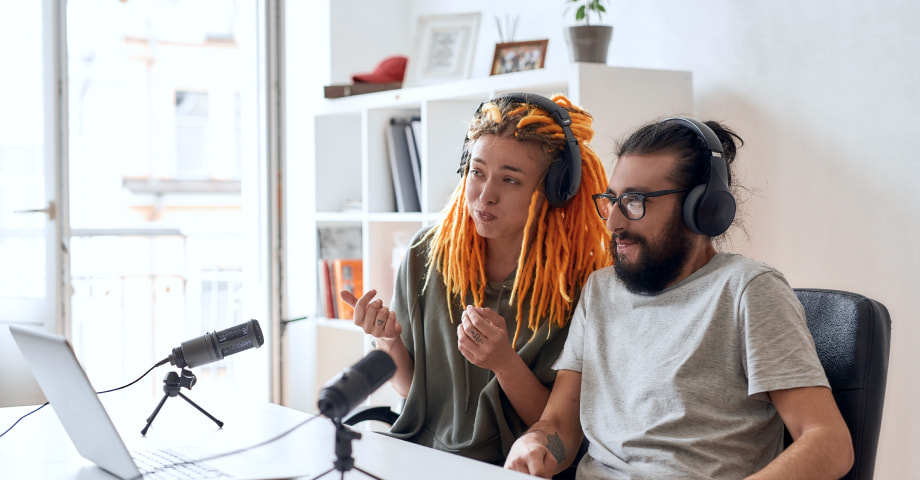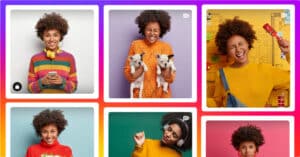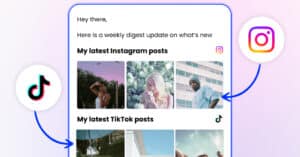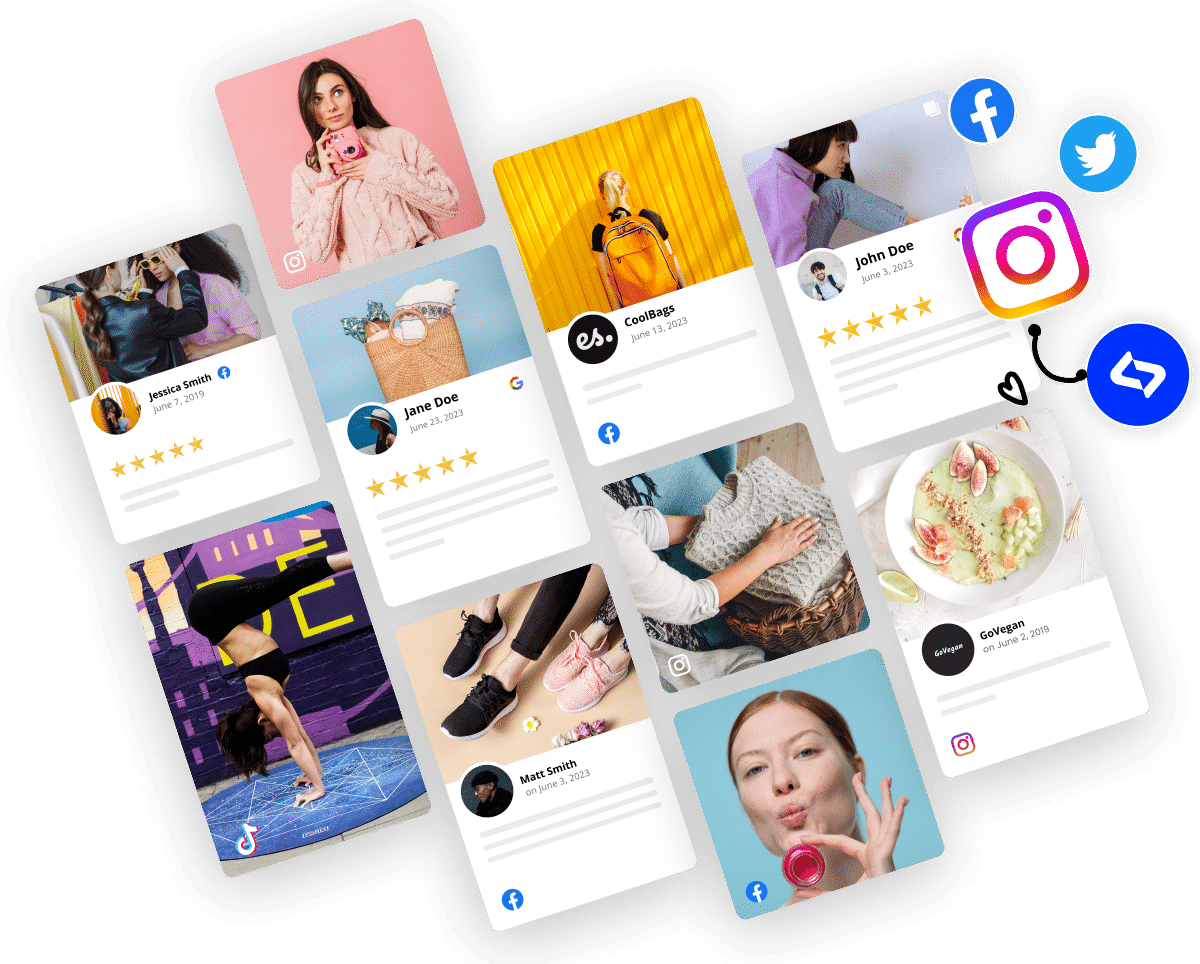Influencers are one of the best influencer marketing platforms and weapons that businesses use for their products and services promotion; social media growth increases brand awareness, reputation, and similar.
The user-generated content they provide, whether in an Instagram story format or a TikTok video, reaches people more authentically, building trust and directly impacting the brand’s sales metrics.
What is a micro-influencer?
definition
The micro-influencer definition is that they are not celebrities or famous people who are considered macro-influencers (who can reach millions of followers with one post), but they are specialized in one niche and have a big engagement rate from their niche audience.
Micro-influencers usually create content in a specific area for a smaller audience, so brands get hyper-engaging results on their content because of it.
Logically, people will buy from somebody they love and trust. Micro-influencers can make a recommendation for a specific product or service so their small but highly interested audience will respond.
Businesses can practice this word-of-mouth promo method and reach their business goals.
FYI: Feedlink Link in BIo tool helps small business owners and UGC creators consolidate all their tools in one platform and save tons of time and money to build link-in-bio pages, publish blogs, newsletters and social media posts.
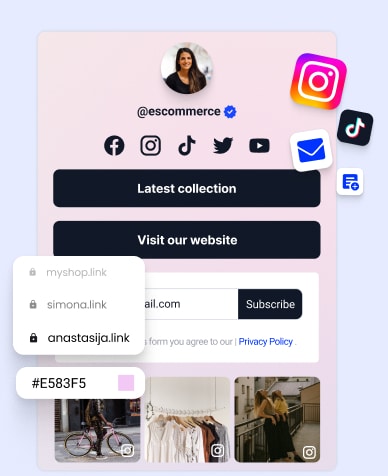
Convert followers to customers with the best link in bio tool on the planet.
Consolidate tools and cut costs with a free blog, newsletter, and social media publishing. Plus 1 year free link domain.
Benefits of micro-influencer marketing
Micro-influencer marketing has gained traction in recent years due to its unique advantages over traditional influencer marketing. Here are some of the key benefits of micro-influencer marketing:
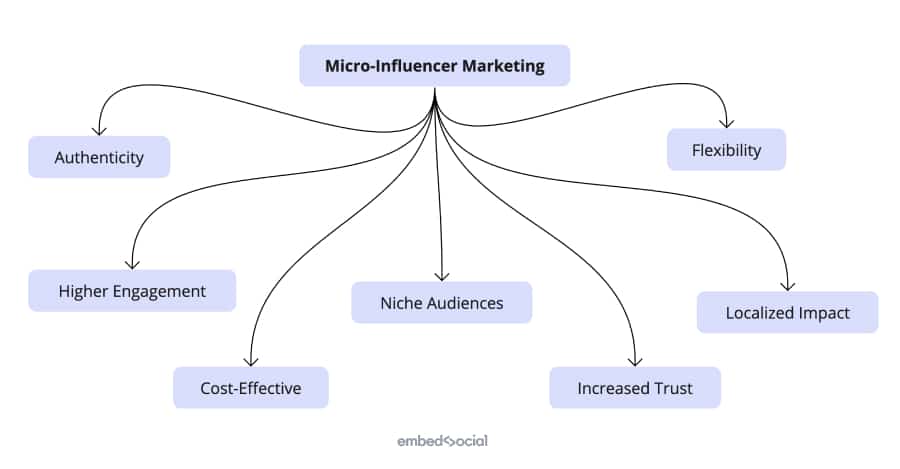
Authenticity and trust
Micro-influencers often have a close-knit community of followers who trust their opinions. Their recommendations come across as genuine and authentic, which can lead to higher engagement and trustworthiness.
A skincare brand can partner with a micro-influencer who has struggled with acne. The influencer shares their personal journey and how the brand’s products helped them, making the endorsement feel genuine and relatable to followers with similar skin concerns.
Example
Higher engagement rates
Studies have shown that micro-influencers tend to have higher engagement rates compared to mega-influencers. Their followers are more likely to interact, comment, and share their content.
A local bakery can collaborate with a micro-influencer. While the influencer might has only 5,000 followers, their post about the bakery’s pastries can receive numbers such as 500 likes and 50 comments, indicating a 10% engagement rate, which is significantly higher than industry averages.
Example
Cost-effective
Working with micro-influencers can be more budget-friendly than partnering with larger influencers or celebrities. This allows brands to collaborate with multiple micro-influencers for the price of one mega-influencer, diversifying their reach.
A startup fashion brand with a limited budget can partner with ten micro-influencers instead of one celebrity. Each micro-influencer posts about the brand, resulting in diverse content and reach for the same price.
Example
Niche targeting
Micro-influencers often cater to specific niches or interests. Collaborating with them allows brands to target a specific audience more effectively, ensuring that the marketing message reaches those most likely to be interested.
A vegan snack company can collaborate with a micro-influencer who focuses on plant-based diets. Their followers, being interested in vegan products, are more likely to try the snack based on the influencer’s recommendation.
Example
Flexibility and creativity
If you are a travel agency and collaborate with a micro-influencer, you can allow them to create a unique travel vlog series. The influencer can suggest a mix of blog posts, videos, and Instagram stories, offering varied content that resonates with different segments of their audience.
Example
How to find micro-influencers on social media platforms
You can find micro-influencers by manually searching social media platforms. Depending on the platform, you can search by hashtags, keywords, explore/discovery pages, etc.
Or, if you need hundreds or thousands of micro-influencers for outreach, you can order a custom email list of influencers.
Not only it’s faster, but creator data providers such as Influencers Club can filter influencers by niche, audience size, location, past brand collaborations, and more, so you can get a list of influencers that align it your business.
But if you need only a few, here’s a step-by-step guide on how to find micro-influencers on social media platforms for free:
How do you find micro-influencers on Instagram?
We all know that Instagram is the most popular social media influencer platform worldwide, with over 1.3 billion users. There are many celebrities, famous people from all spheres, big influencers, and micro-influencers too. If you are in a situation of finding micro-influencers for your brand on Instagram, you need to take care of several things.
Hashtag search
Use relevant industry or niche hashtags to discover influencers posting content in your domain.
First, you can take a look at social media followers using some hashtags. Search for hashtags that match your niche and your brand image, too. You can find your nano-influencers and micro-influencers browsing a specific hashtag used on their posts.
For example, if your brand is in the fitness niche, search for hashtags like #fitnesscoach or #fitnesstrainer to find fitness individuals with 10,000 to 50,000 followers.
Example
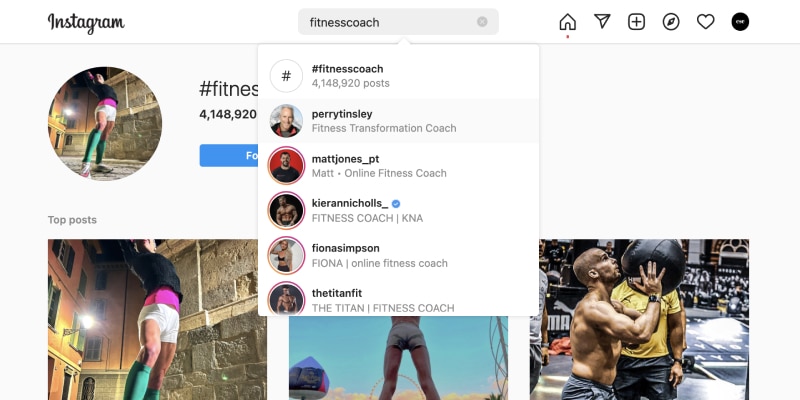
Explore page
The Instagram Explore page often showcases popular content tailored to your interests, which can lead to potential influencers.
Check the following list of your followers
Next, you can check the following list of your followers. The chances are big that they follow other big accounts on Instagram in your niche at the moment. Follow what your followers follow and be in touch with the mega-influencers and micro-influencers your target audience likes.
Also, If you have a business account, Instagram Insights can show you accounts that your audience also follows.
Instagram’s “Suggested Users” feature:
When you follow an influencer, Instagram will suggest similar profiles. However, before hiring somebody, keep in mind that a micro-influencer on Instagram can cost you between $200 and $800 per sponsored post.
Read more: How to make money on Instagram?
Further reading
How to find micro-influencers on TikTok?
When it comes to TikTok, things are very similar. TikTok is one of the fastest-growing social media platforms, with over 750 million users. The thing is, if your micro-influencers are on Instagram, they are probably on TikTok too. it is the favorite platform for younger audiences, especially Gen Z, making it a hotspot for influencer marketing.
Discover page
TikTok’s Discover page is a curated feed that showcases trending content and creators. It’s an excellent starting point for brands to identify influencers who are creating viral content. The Discover page also highlights trending hashtags, which can lead to influencers participating in those trends.
To check this out, browse some hashtags relevant to your niche as you did on Instagram. Also, you can search for the hashtag #ad + add a keyword that matches your brand. You can find micro-influencers that directly promote products or services on TikTok to their audience.
Hashtag challenges
TikTok is known for its viral hashtag challenges. Brands can observe these challenges to identify influencers who are not only participating but also driving engagement. Some influencers even create their own challenges, which can go viral, indicating their influence and reach on the platform.
Sound Search: Music is a significant driver of content on TikTok. Popular tracks often lead to trending videos. By searching for trending sounds or music tracks, brands can discover influential creators who have used them in their videos, indicating their knack for creating trending content.
Engage with content
Before reaching out for collaborations, brands can engage with potential influencers by liking, commenting, and sharing their videos. This not only helps in building a relationship but also provides insights into the influencer’s engagement rates and audience interactions.
TikTok analytics (for Pro accounts)
If influencers have a Pro account, they have access to TikTok Analytics, which provides data on their content performance, audience demographics, and more. Brands can request this data when considering collaborations to ensure a good fit with their target audience.
FYI: You can embed TikTok widget automatically with EmbedSocial’s UGC platform. Start a free trial and display your social media widgets now.
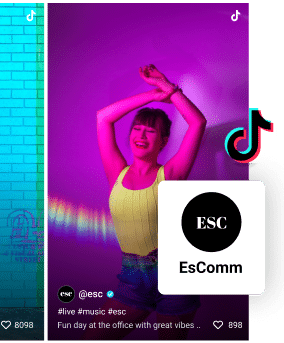
Show TikTok videos on your website automatically!
Try EmbedFeed and add TikTok videos, Instagram, YouTube or Facebook feeds to your website.
All PRO features | Cancel any time.
How to find micro-influencers on YouTube?
YouTube is the 2nd biggest search engine on the internet after Google. That means people browse videos for something they need or for fun. Finding small YouTubers or micro-influencers here is crucial because they handle smaller target audiences well, engaging with them is easy, and the costs are lower.
Keyword search
Search for keywords related to your industry to find top creators.
To find smaller YouTubers, you can search for them on Google. YouTube is a platform owned by Google, so it will recommend some popular videos in your niche in the tab Videos.
For example, your brand is in the beauty niche.
You can type “beauty YouTubers,” and in the Videos tab, Google will show you many videos related to beauty, make-up, tutorials, beauty product reviews, etc. Or go directly into YouTube search and do the same with very specific search terms that influencers usually use to create videos, such as “my skincare routine.” Create a list of your favorite video creators and contact them for collaboration.
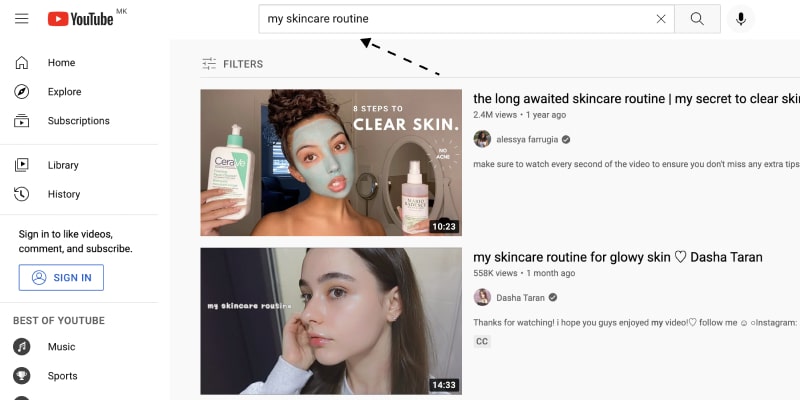
Searching for hashtags is an evergreen method for finding relevant content or creators on social media. You need to find YouTubers who already worked with other brands and get engagement on their recommendations. Search for a hashtag #ad + your niche, and you will find videos where YouTubers directly promote products on their videos.
Next, you can check them up on YouTube trends. Open the Trending tab on YouTube, where you can see many popular videos at the moment. Search for videos in your niche, and you will find video creators that will match your brand image. These videos are also known as sponsored videos, and there is a tag on them.
Check playlists
Some users create playlists featuring influential creators in specific niches. Playlists can be a treasure trove as they might feature content from multiple influencers in a specific niche.
For example, your brand is in the pet niche, and you have a product for dog grooming. Use keyword phrases in the search bar like “pet grooming influencers” or “dog grooming creators” to find playlists that might promote relevant YouTubers.
Example
Channel recommendations
YouTube often suggests channels based on your viewing history. Based on viewing history, YouTube suggests channels help brands find influencers with similar content.
How to find micro-influencers on LinkedIn?
LinkedIn is a business-related social media platform with over 65 million users. People often use LinkedIn for job-seeking purposes or hiring for their companies, but it can also be a great market for your brand.
Many employers and employees have accounts there, so collaboration with micro-influencers can be very beneficial for you to build brand awareness.
LinkedIn search
A simple keyword search can lead brands to professionals who are considered thought leaders in their industry.
Keyword research is one of the first things you should try to find micro-influencers on LinkedIn. Type in a specific keyword that matches your niche, and LinkedIn will list relevant profiles and pages.
You can DM them directly on the platform chat or use their email in the contact info tab.
Next, you can do an author search. Everyone on LinkedIn can write or post content of any kind, so search for content authors in your niche. Check the most popular posts related to your brand and connect with the authors for potential collaboration.
Checking out biographies is another way of finding micro-influencers. You can use search filters, and LinkedIn will show you a list of relevant profiles. Open up some profiles and see their specialty in bio.
For example, you have a reviews management software and you need a micro-influencer for product or service promotion. You can type “reputation management consultant” or “reputation speaker” in the search bar and choose a profile from the result list. You can check the “People Also Viewed” section for similar accounts and connect with them.
Example

Join LinkedIn groups
In the end, we can mention the LinkedIn groups.
LinkedIn groups are hubs for professionals to share insights articles, and engage in discussions. Engaging in these groups can lead to discovering influential voices in the industry.
Search for groups related to your business and request membership. Inside, you can connect with many people in your niche with the same interests. Find accounts with more than 10,000 followers and connect with them for collaboration.
How to find micro-influencers on Facebook?
Facebook remains one of the most widely used social media platforms, making it a valuable space for influencer marketing.
Facebook groups
Facebook groups are communities where users with shared interests gather to discuss topics, share content, and engage with one another. Many influencers either create their own groups or are active members of niche-specific groups. Brands can join these groups to observe discussions, identify active and influential members, and even directly engage with potential influencers.
For example, type your industry niche and add influencers, click the Groups tab on the left, and you will get filtered results of groups like the example below:
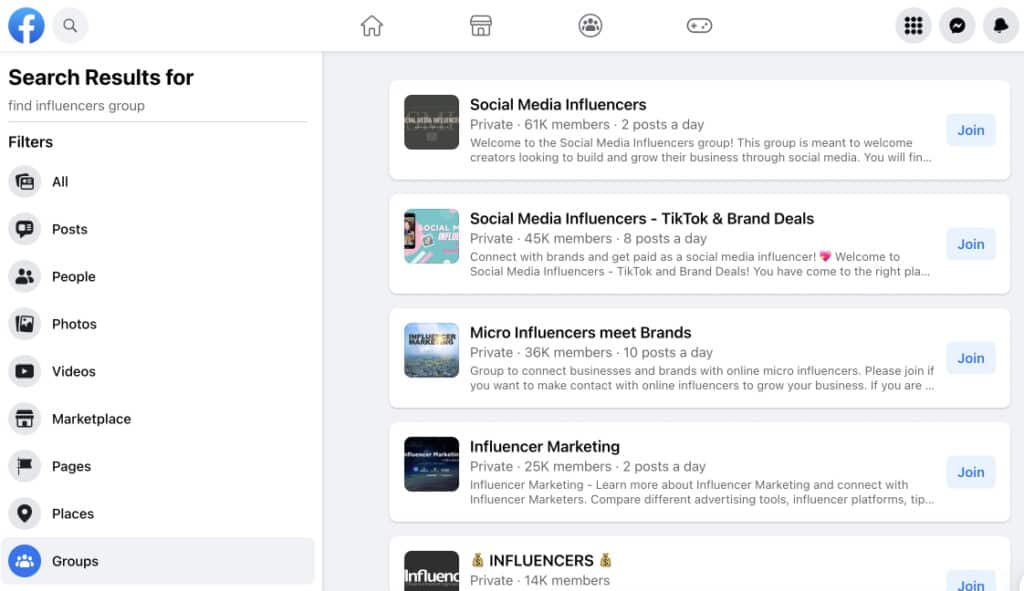
Pages search
Influencers often create dedicated Facebook pages to share their content, engage with their audience, and collaborate with brands. By searching for pages related to your industry or niche, brands can discover influencers who have cultivated a dedicated following. Analyzing the content, engagement rates, and audience feedback on these pages can provide insights into the influencer’s credibility and relevance to your brand.
Facebook Recommendations
Facebook often suggests similar pages when users engage with a particular page by liking or following it. This feature can lead brands to other influencers in the same niche. It’s a cascading discovery process that can yield multiple potential influencer collaborations.
Facebook Ads library
This tool allows users to see all active ads from a particular page. By analyzing the ads of potential influencers, brands can gauge the influencer’s promotional strategies and collaborations with other brands.
7 Steps on how to work with micro-influencers
Instead of one-off collaborations, consider building long-term relationships with micro-influencers. This can lead to more authentic endorsements and a consistent brand presence among their audience. Here is how to start to work with micro-influencers:
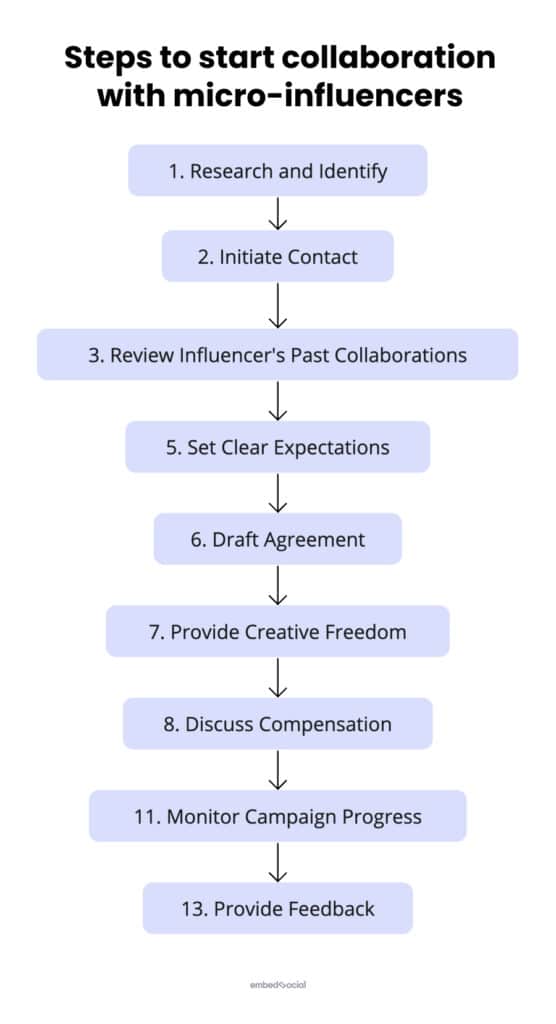
1. Research and Identify
Before reaching out, thoroughly research potential micro-influencers to ensure they align with your brand’s values, aesthetics, and target audience. Look at their content quality, engagement rates, and audience feedback.
2. Initiate contact
Send a personalized message or email expressing your interest in collaborating. Clearly outline what you’re offering and what you expect in return.
3. Set clear expectations
Clearly define the scope of the collaboration. This includes deliverables, timelines, content guidelines, and compensation (if any). It’s essential to be transparent from the start to avoid misunderstandings later.
4. Provide creative freedom
While providing guidelines is crucial, it also allows micro-influencers the creative freedom to present your product or service in a way that resonates with their audience. They know their followers best.
5. Compensation
Decide on the compensation structure. This could be monetary, free products, exclusive discounts, or other incentives. Ensure it’s fair and commensurate with the influencer’s reach and effort.
6. Track and measure
Monitor the performance of the collaboration. Track metrics like engagement, reach, conversions, and ROI. This will help assess the effectiveness of the partnership and inform future collaborations.
7. Feedback and review
After the collaboration, provide feedback to the influencer and also seek their input. This can offer insights for future partnerships and help both parties improve.
Examples of Brands that work with micro-influencers
Many big brands and tech companies successfully collaborate with micro-influencers for product or service promotion.
Spotify raises usage of ‘Discover weekly’ feature on Twitter
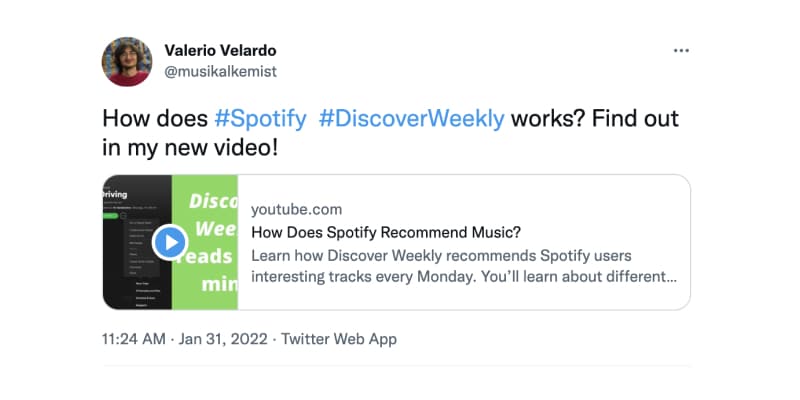
First, we can mention Spotify as one of the leading music platforms in the world. Spotify has collaborated with micro-influencers for years for their algorithm promotion “Discover Weekly”. Their micro-influencers tweet about Spotify products and features, making real-life testimonials from their fans.
Coca-Cola’s spreads the #ShareTheMagic campaign with micro TikTok-ers
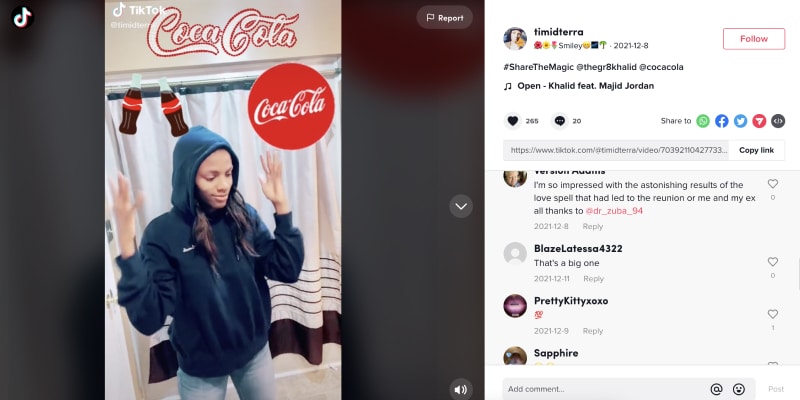
Coca-Cola is using micro-influencers to promote its drink across the world. Their marketing strategy is for people on their social media accounts with less than 100,000 followers to travel, do sports, eat food together with Coca-Cola, dance, and show the enjoyment of drinking it.
Amazon promotes Audible with micro YouTubers
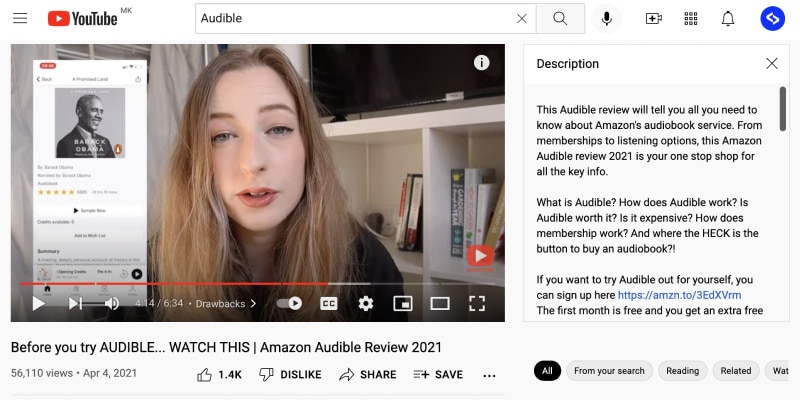
Amazon, one of the world’s business giants, uses micro-influencers for their audiobook Audible. They use sponsored videos with smaller YouTubers and spread the word on other platforms.
Amazon also hires micro-influencers on Instagram to use their audiobook and make recommendations in the music/audio niche.
Gro-To collaborates with moms to spread new product line on Instagram
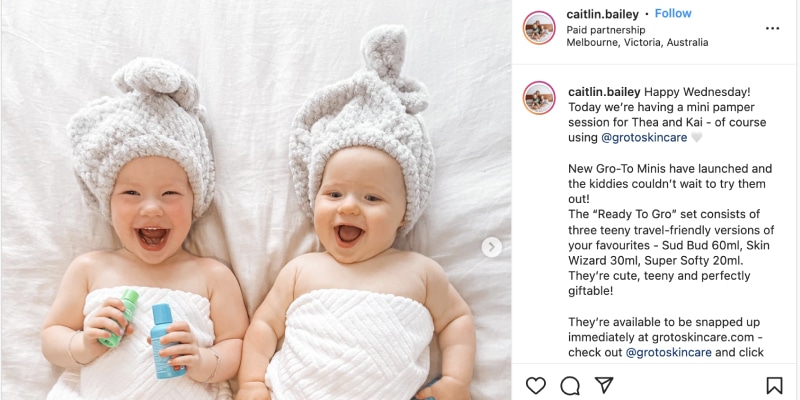
Finally, here is a smaller company from Australia, Gro-To, and they collaborate with actual micro-influencers to reach their niche market.
They work with Caitlin Bailey, a mom of two who shares personalized photos of her babies using the new Gro-TO product line on Instagram.
Read more: Micro influencer ideas for instagram >
Further reading
Practical Incentives for micro-influencers (discounts, product samples)
Many micro-influencers will agree on collaboration to give out products, gift cards, promo codes, etc.
All rewards are high-perceived and bring benefits to the micro-influencers and their audience.
For example, giving out gift cards will help people to interact with your brand continuously in the future. Micro-influencers can make a recommendation for it, and their audience will have a gift from your brand directly.
You can also reward your micro-influencers with direct access to your brand.
Example DM messages to reach out to micro-influencers
Reaching out to micro-influencers can be a challenging task for businesses. It’s not that easy to grab their attention to open up your DMs. Here are some examples of DM messages to reach out to micro-influencers:
Hello [Micro-influencer name],
We found your posts about [your niche], and you have great content! We are a [your niche] brand, and we offer products that may be interesting and helpful for your audience. If you agree, we will send you some of them to check and recommend to your audience.
Hope you will see an opportunity for collaboration,
Many thanks [Your brand’s name].
Hey [Micro-influencer name],
We are on our way to launching a new marketing campaign for [your product]. We found your profile as an awesome place to help us with promotion. Because you are focused on [your niche], we would like to make a deal with you to be a part of our brand.
Waiting for your answer,
[Your brand’s name] team
UGC tools to capture micro-influencers content
The UGC platform is uniquely designed to help brands monitor and generate all social media posts that mention their brands to re-use them as evidence on their website in social proof formats.
The most useful tools and use cases for brands doing influencer marketing campaigns are the following:
EmbedReviews – reviews aggregator

EmbedReviews is a tool designed to collect, manage, and display user reviews from various platforms. When it comes to capturing and generating micro-influencers, EmbedReviews collects Facebook and Google reviews. Among these reviews, brands can identify satisfied customers who show potential as micro-influencers.
Additionally, aggregating genuine user reviews is a goldmine for finding authentic brand advocates. These are individuals who already love the product or service and are vocal about their positive experiences. They can be nurtured into becoming micro-influencers.
And finally, by showcasing real user reviews on a website or social media, brands can build trust with their audience. When potential micro-influencers see this transparency, they may be more inclined to collaborate, knowing the brand values authenticity.
EmbedFeed – Social media aggregator

Use EmbedFeed to aggregate all posts that include a specific hashtag and are publicly shared on YouTube, Instagram, or Twitter. This is extremely useful when your company collaborates with influencers who use a branded hashtag to communicate the sponsored campaign on social media.
The social media aggregator is equipped with API integrations, allowing the system to pull this data in real-time and store it in one place. Additionally, brands can create social media widgets and create hashtag walls with all the user-generated content from their micro-influencers.
See the Instagram hashtag wall in action.
Why Consider Micro-Influencers for Your Influencer Marketing Campaign
Now is the perfect time for marketers to implement micro-influencer campaigns in advertising and overall marketing strategies.
Using small influencers with a decent following but who pay influencers with stronger relationships with your niche audiences is a perfect formula for success.
FAQ about Micro-influencers:
Social media influence refers to the ability of an individual, group, or brand to sway or impact the opinions, behaviors, or decisions of others on social media platforms. This influence is often derived from the perceived authority, knowledge, position, or relationship the influencer has with their audience.
Micro-influencers usually set the price by themselves, and their services have no fixed rates. Generally, they charge around $10 for every 1000 followers, which means that for 10,000 followers, micro-influencers can charge at least $100 for marketing purposes.
Search for them manually. Search for micro-influencers in your niche on every social media platform relevant to your brand. You can use hashtags, keyword phrases, and similar. Next, follow what your followers follow and get in touch with them. If you are on a budget, use an influencer marketing platform to find relevant micro-influencers for your business or hire an agency for the same purpose.
You can hire micro-influencers on Instagram to do a sponsored post with your product or service, be your brand ambassadors, do your outreach, or invite other influencers in your niche to support your brand.
A micro-influencer typically has a following that ranges from 1,000 to 100,000 followers on social media platforms. They are characterized by their niche audience and higher engagement rates compared to influencers with larger followings. The specific range can vary based on the platform and industry, but this is the general guideline used by many in the influencer marketing industry.
Brands should evaluate the micro-influencers audience demographics, engagement rates, content quality, and past collaborations. It’s also essential to ensure that the influencer’s values and aesthetics align with the brand’s image.
FYI: Feedlink Link in BIo tool helps small business owners and UGC creators consolidate all their tools in one platform and save tons of time and money to build link-in-bio pages, publish blogs, newsletters and social media posts.

Convert followers to customers with the best link in bio tool on the planet.
Consolidate tools and cut costs with a free blog, newsletter, and social media publishing. Plus 1 year free link domain.

